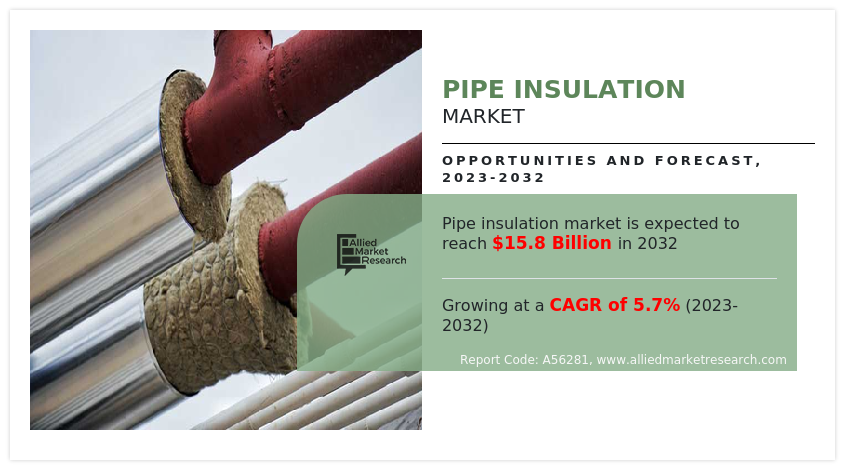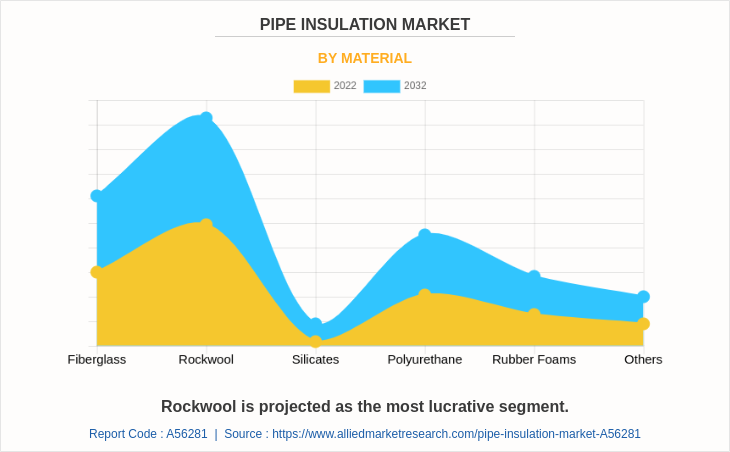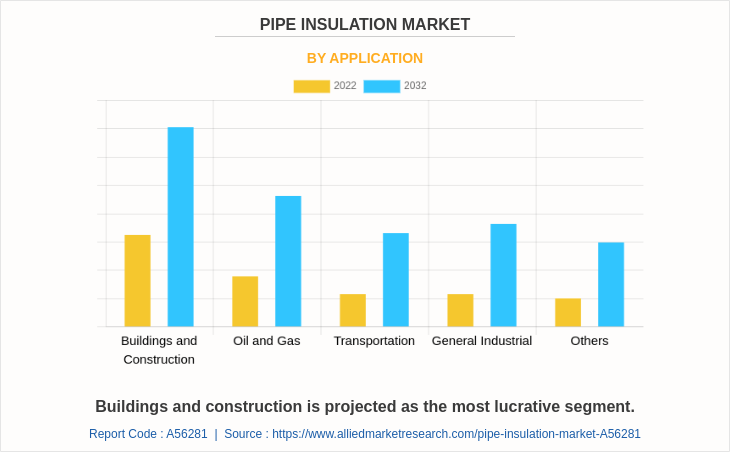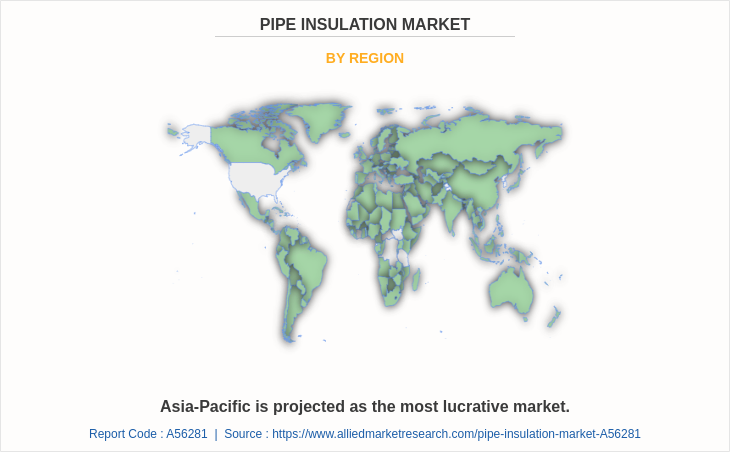Pipe Insulation Market Research, 2032
The global pipe insulation market was valued at $9.1 billion in 2022, and is projected to reach $15.8 billion by 2032, growing at a CAGR of 5.7% from 2023 to 2032. The growth in industrial and commercial construction is a significant driver of the pipe insulation market, as new buildings and facilities require effective insulation solutions to enhance energy efficiency and reduce operating costs.

Introduction
Pipe insulation refers to the material used to wrap or cover pipes to minimize heat transfer and prevent energy loss, condensation, and freezing. It is essential in various applications, including residential, commercial, and industrial settings. Insulation is typically applied to pipes carrying hot or cold fluids, helping to maintain the desired temperature and improve energy efficiency. By reducing heat loss in hot water pipes and preventing heat gain in chilled water lines, pipe insulation contributes significantly to energy conservation efforts.
Report key highlighters
- Quantitative information mentioned in the global pipe insulation market includes the market numbers in terms of value (USD Million) with respect to different segments, pricing analysis, annual growth rate, CAGR (2023-32), and growth analysis.
- The analysis in the report is provided based on material and application. The study will also contain qualitative information such as the market dynamics (drivers, restraints, opportunities), Porter's Five Force Analysis, key regulations across the region, and value chain analysis.
- A few companies, including Armacell, BASF SE, Dow, Huntsman International LLC, Johns Manville, Kingspan Group, Knauf Insulation, Lydall, Inc., Owens Corning, and Saint-Gobain, hold a large proportion of the pipe insulation market.
- This report makes it easier for existing market players and new entrants to the prepreg business to plan their strategies and understand the dynamics of the industry, which ultimately helps them make better decisions.
Market Dynamics
Pipe insulation is the procedure of insulating or coating pipes with a material to reduce heat gain or loss, avoid condensation, and protect against freezing. It involves wrapping insulating material around the pipes to form a barrier that helps preserve the desired temperature of the fluid passing through the pipes. Pipe insulation is frequently used in residential, commercial, and industrial applications where pipes transport hot water, steam, or other fluids. It has various advantages, including increased system performance, cost savings, and energy efficiency. Insulation helps minimize energy loss by reducing heat transmission, which lowers the cost of heating or cooling. In addition, it prevents condensation on cold pipes, which may result in mold growth, corrosion, and moisture damage.
However, the primary materials used in pipe insulation such as fiberglass, foam, and polyethylene, are often subject to price volatility due to various factors, including supply chain disruptions, changes in demand, and geopolitical tensions. When raw material costs rise unexpectedly, manufacturers face increased production expenses, leading to higher prices for end products. All these factors hamper the growth of the pipe insulation market during the forecast period.
As R&D in insulation materials and techniques continue to evolve, newer and more efficient solutions are emerging. These innovations include high-performance materials such as aerogels, polyurethane foams, and phase-change materials that offer superior thermal insulation properties compared to traditional options. These advanced materials improve energy efficiency but also provide enhanced durability, flexibility, and fire resistance, which make them suitable for a wide range of industrial and commercial applications. All these factors are anticipated to offer new growth opportunities for the global pipe insulation market during the forecast period.
The wide utilization of pipe insulation in various end-use industries, including building and construction, aerospace, oil, and gas, drives the growth of the pipe insulationmarket. Plumbing pipes are covered with insulation to prevent heat loss in systems that distribute hot water. Insulating hot water pipes help maintain water temperature, speed up the process of getting hot water to taps and showers, and save energy. In cold areas, it also prevents pipes from freezing, reducing the possibility of pipe bursts and associated water damage. Buildings may use pipe insulation as a fire safety precaution. Insulation for fire-rated pipes helps control the spread of fire by creating a barrier that slows heat transmission and preserves the pipe's integrity. In addition, fire-resistant insulating materials are used to comply with specific fire safety requirements and codes.
Furthermore, pipe insulation may also achieve reduced noise transmission through pipes. It works to reduce the sound made by fluid flow or mechanical vibrations by constructing an acoustic layer around the pipes. This is especially crucial in institutions such as hospitals, schools, or apartment complexes where noise control is required. Moreover, HVAC (heating, ventilation, and air conditioning) systems frequently use pipe insulation. It helps reduce heat gain or loss in pipes that transport hot or cold water, enhancing system performance and energy efficiency. By insulating HVAC pipes, condensation is also less likely to occur, which helps prevent moisture damage and improve indoor air quality. These factors contribute to the growth of the pipe insulation market in the building and construction sectors.
The growth of the pipe insulation market is influenced by the development of industrial production infrastructure. As industries continue to develop and expand, the need for effective and sustainable solutions to improve energy conservation, decrease heat loss, and ensure the smooth functioning of industrial processes is growing. This has increased the demand for improved pipe insulation systems in various industries, including oil and gas, chemical, power generation, pharmaceuticals, food processing, and others.
The construction and upgrading of factories, plants, and manufacturing facilities are part of the development of the industrial production infrastructure. These industrial settings require an extensive network of pipes to carry fluids, steam, and gases for various uses. Pipe insulation installation is essential to maintain the optimum temperature, reduce energy loss, prevent condensation, and ensure maximum operating effectiveness.The expansion of industrial production infrastructure in emerging economies presents significant market potential for pipe insulation. As these nations experience rapid industrialization and infrastructural development, there is a surge in demand for reliable insulating products to support their expanding manufacturing sectors.
This creates more opportunities for market participants to form collaborations, grow their customer bases, and meet the changing needs of these emerging markets. Therefore, the rising industrial infrastructure development is expected to significantly increase the demand for the pipe insulation market during the forecast period.
The pipe insulation market is noticeably impacted by fluctuations in the cost of raw materials for pipe insulating products. Fiberglass, mineral wool, foam, and rubber are some raw materials used in pipe insulation that might vary in price depending on many variables. The availability and sourcing of the products are two crucial factors influencing raw material prices.
Market Segmentation
The pipe insulation market is divided on the basis of material, application, and region. On the basis of material, the market is classified into fiberglass, rockwool, silicates, polyurethane, rubber foams, and others. On the basis of application, the market is divided into building and construction, oil and gas, transportation, general industrial, and others. On the basis of region, the market is analyzed across North America, Europe, Asia-Pacific, and LAMEA.
The key players operating in the pipe insulation market are Armacell, BASF SE, Dow, Huntsman International LLC, Johns Manville, Kingspan Group, Knauf Insulation, Lydall, Inc., Owens Corning, and Saint-Gobain. These players have adopted various key strategies including expansion, agreement, and acquisition to increase their market share. These players have adopted various key strategies including agreement, collaboration, expansion, and partnership to increase their market shares.

Pipe Insulation Market By Material
The rockwool segment held the largest market share in 2022. Rockwool is an environmentally friendly material, as it is made from natural and sustainable resources. Its production involves recycling materials and utilizing renewable energy sources, contributing to sustainability efforts in the construction and insulation industries.

Pipe Insulation Market By Application
The buildings and construction segment held the largest market share in 2022. the growing awareness of environmental impact and the need for sustainable construction practices. Pipe insulation materials that offer high thermal performance and are made from recycled or renewable resources are increasingly being favored. The use of sustainable pipe insulation solutions aligns with green building certifications and helps in achieving sustainable construction goals.

Pipe Insulation Market By Region
The market is categorized into North America, Europe, Asia-Pacific, and LAMEA. The Asia-Pacific region is one of the fastest-growing regions in the world. The booming oil and gas industry in the Asia-Pacific region is driving the demand for pipe insulation. As the region continues to invest in oil and gas exploration and production, there is a growing need for insulated pipelines to ensure the efficient transportation of fluids. Pipe insulation provides thermal protection, prevents corrosion, and reduces the risk of leaks, making it indispensable in the industry.
Public Policies
Energy Efficiency Standards: Jurisdictions have adopted energy efficiency codes that specify insulation requirements for pipes to minimize heat loss or gain. These standards are aligned with national codes, such as the International Energy Conservation Code (IECC) in the U.S. The guidelines dictate the minimum insulation thickness, material types, and R-value (thermal resistance) necessary for different applications, ensuring that buildings maintain energy efficiency and reduce greenhouse gas emissions.
Fire Safety Regulations: Pipe insulation materials must comply with fire safety regulations to prevent fire hazards and ensure safe evacuation in case of emergencies. The National Fire Protection Association (NFPA) in the U.S. provides guidelines on the use of fire-rated insulation materials and their installation, which include specific fire resistance ratings (e.g., ASTM E84 or UL 723).
Health and Environmental Regulations: The choice of insulation materials is influenced by health and environmental regulations. Materials must be free from harmful substances, such as asbestos, which is banned in many regions due to its carcinogenic properties. In addition, insulation manufacturers must comply with regulations such as the Environmental Protection Agency (EPA) guidelines on volatile organic compounds (VOCs), ensuring that products emit low levels of harmful chemicals into indoor air.
Key Developmental Strategies Undertaken by Key Players
- In October 2022, The Knauf Group announced its plans to increase mineral wool production capacity within Central and Eastern Europe by investing close to $143 million in Knauf Insulation’s facility in Tarnaveni, Romania. This investment is projected to allow the company to significantly increase its annual production output, manufacturing more than 75,000 tons of mineral wool every year to meet the growing demands in Central and Eastern Europe. This expansion is anticipated to boost the demand for pipe insulation market.
- In March 2022, Armacell, a global leader in flexible foam for the equipment insulation market and a leading provider of engineered foams, established a new facility in Singapore to provide unique mechanical, thermal, and acoustic insulation and protection systems to customers in the region. With this expansion, additional local and regional HVAC and construction companies are projected to be supported by innovative system solutions built on ArmaFlex and ArmaGel flexible insulation materials leading to the growth of the market.
- In January 2022, Armacell acquired the engineering business of SpiderPlus &, Co. Ltd. The engineering business SpiderPlus & Co. Ltd. is based in Tokyo, Japan, and produces and offers piping and ductwork thermal insulation systems. Through this acquisition, Armacell is projected to be better positioned to serve the local construction and HVAC industries with ArmaFlex products that are the market leader in thermal insulation in Japan.
Key Benefits For Stakeholders
- This report provides a quantitative analysis of the market segments, current trends, estimations, and dynamics of the pipe insulation market analysis from 2022 to 2032 to identify the prevailing pipe insulation market opportunities.
- The market research is offered along with information related to key drivers, restraints, and opportunities.
- Porter's five forces analysis highlights the potency of buyers and suppliers to enable stakeholders make profit-oriented business decisions and strengthen their supplier-buyer network.
- In-depth analysis of the pipe insulation market segmentation assists to determine the prevailing market opportunities.
- Major countries in each region are mapped according to their revenue contribution to the global market.
- Market player positioning facilitates benchmarking and provides a clear understanding of the present position of the market players.
- The report includes the analysis of the regional as well as global pipe insulation market trends, key players, market segments, application areas, and market growth strategies.
Pipe Insulation Market Report Highlights
| Aspects | Details |
| Market Size By 2032 | USD 15.8 billion |
| Growth Rate | CAGR of 5.7% |
| Forecast period | 2022 - 2032 |
| Report Pages | 253 |
| By Material |
|
| By Application |
|
| By Region |
|
| Key Market Players | Owens Corning, Lydall, Inc., Huntsman International LLC, Dow, Johns Manville, Armacell, BASF SE, Kingspan Group, Saint-Gobain, Knauf Insulation |
Analyst Review
According to the opinions of various CXOs of leading companies, the global pipe insulation market is witnessing substantial growth, driven by the increasing demand for energy efficiency, sustainability, and thermal insulation across various industries. The stringent regulations and policies aimed at reducing greenhouse gas emissions and energy consumption are pushing industries to adopt effective insulation solutions. In addition, the need to minimize energy wastage and achieve cost savings is driving the market expansion. The construction sector is a significant driver, with the growing demand for residential and commercial buildings as well as infrastructure development projects worldwide. The high cost of advanced insulation materials and the lack of awareness about the long-term benefits of insulation are expected to hinder the market growth. In addition, alternative insulation materials and the complexity of retrofitting insulation in existing infrastructure pose challenges for the market.
Nevertheless, key trends are shaping the pipe insulation market. The development of eco-friendly and sustainable insulation materials, such as mineral wool and aerogel, is gaining traction, offering superior thermal performance and reducing environmental impact. Another trend is the increasing adoption of pre-insulated pipe systems, which streamline installation processes and provide enhanced insulation efficiency. The market also presents significant opportunities for growth and innovation. The expanding focus on energy-efficient and sustainable construction practices, coupled with the retrofitting of insulation in existing infrastructure, offers substantial market potential. In addition, emerging economies experiencing rapid industrialization and infrastructure development provide opportunities for market players to cater to the growing demand for pipe insulation solutions.
The increasing focus on energy-efficient building renovations and retrofitting projects led to the adoption of pipe insulation solutions in older structures. Insulation upgrades were seen as an effective way to improve energy performance without significant structural changes.
Buildings and Construction application are the potential customers of Pipe Insulation Market industry
Asia-Pacific region will provide more business opportunities for Pipe Insulation Market in coming years
The market players are adopting various growth strategies and also investing in R&D extensively to develop technically advanced unique products which are expected to drive the market size.
Armacell, BASF SE, Dow, Huntsman International LLC, Johns Manville, Kingspan Group, Knauf Insulation, Lydall, Inc., Owens Corning, and Saint-Gobain are the top players in Pipe Insulation market.
Loading Table Of Content...
Loading Research Methodology...



